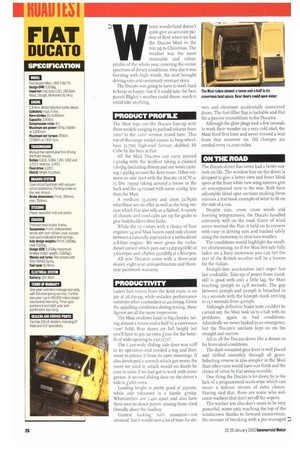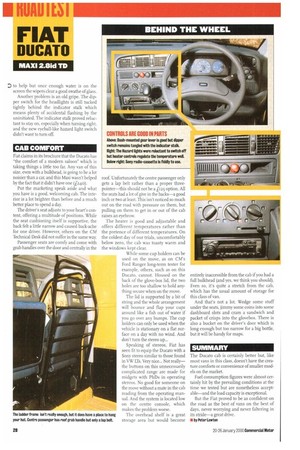inter wonderland doesn't quite give an accurate picture of Kent
Page 28

Page 30

If you've noticed an error in this article please click here to report it so we can fix it.
when we had the Ducato Maxi in the run up to Christmas. The weather was the most miserable and inhospitable of the whole year, covering the entire spectrum of dreary conditions. One day it was freezing with high winds, the next brought driving rain and ominously overcast skies,
The Ducato was going to have to work hard to keep us happy, but if it could take the best punch Blighty's weather could throw, surely it could take anything.
PRODUCT PROFILE
The Maxi tops out the Ducato line-up with three models ranging in payload volume from I0M3 to the 12m3 version tested here. This top-of-the-range model conies in long-wheelbase (3.7m) high-roof format; dubbed Hi Cube by the boys at Fiat.
All the Maxi Ducatos can carry around T,500kg with the beefiest taking a claimed 1,615kg (including driver) and our tester carrying 1,450kg around the Kent route. Other versions on sale start with the Ducato to (CM 9'5 Dec 1999) taking around a tonne in the back and the 14 variant with some 200kg less than the Maxi.
A medium (3.2om) and short (2.85m) wheelbase are on offer as well as the long version which Fiat also sells as a flatbed. A variety of chassis and cowl-cabs are up for grabs to give bodybuilders their kicks.
While the to comes with a choice of four engines; 14 and Maxi buyers need only choose between a naturally aspirated or a turbo-diesel 2.8-litre engine. We were given the turbodiesel variant which puts out i2ihp (9okW) at 3,600rprn and 285Nm (2tolbft) at 1,800rpm.
All new Ducatos come with a three-year dealer, eight-year anti-perforation and threeyear paintwork warranty.
PRODUCTIVITY
Laden fuel return from the Kent route is on par at 26.6mpg, while unladen performance outstrips other contenders at 40.6mpg. Given the appalling conditions during testing, these figures are all the more impressive.
The Maxi swallows loads in big chunks, taking almost a tonne-and-a-half in a cavernous tzmi hold. Rear doors are full height but you'll have to pay an extra £200 for the benefit of wide opening to 250/270*.
The 1.2m-wide sliding side door was stiff in its operation and needed a tug and then some to release it from its open moorings. It also developed a screech which got worse the more we used it, which would no doubt be easy to solve if we had got to work with some grease. A second sliding door on the driver's side is 1260 extra.
Loading height is pretty good at 555mm, while axle tolerance is a handy 470kg. Wheelarches are 1.4111 apart and also have their own tie-down points among those sited liberally about the loadbay.
Central locking isn't standard—not unusual, but it would save a lot of time for dri
vers and eliminate accidentally unsecured doors. The fuel-filler flap is lockable and Fiat fits a passive immobiliser to the Ducatos.
Although the glow plugs took a few seconds to work their wonder on a very cold start, the Maxi fired first time and never missed a beat from that moment on. Oil changes are needed every 12,000 miles.
ON THE ROAD The Ducato driver has never had a better outlook on life. The window line on the doors is dropped to give a better view and fewer blind spots at the front while new wing mirrors give an unsurpassed view to the rear. Both have adjustable blind spot sections making these mirrors a text-book example of what to fit on the side of a van.
Despite rain, snow, cross winds and freezing temperatures, the Ducato handled extremely well on the road. Gusts of wind never worried the Fiat; it held on to corners with ease in driving rain and tracked safely along the motorway in atrocious weather.
The conditions would highlight the smallest shortcoming, so if the Maxi felt safe fully laden on a busy motorway you can bet the rest of the British weather will be a breeze for the Italian.
Straight-line acceleration isn't super fast but creditable. Take-up of power from standstill is good with only a little lag, the Maxi reaching 50mph in 15.8 seconds, The gap between 30mph and 50mph is breached in to.i seconds with the Gomph mark arriving 111 I3.1 seconds from 4omph.
Although definitive brake tests couldn't be carried out, the Maxi took us to a halt with no problems, again in bad conditions. Admittedly we never braked in an emergency, but the Ducato's anchors kept us on the straight and narrow
All in all the Ducato drove like a dream in far from ideal conditions.
The dash-mounted gear lever is well placed and shifted smoothly through all gears. Selecting reverse is also simpler in the Maxi than other vans would have you think and the choice of ratios by Fiat seems sensible.
One thing the Ducato is let down by is the lack of a programmed wash-wipe which can mean a tedious stream of extra chores. Having said that, there are some who welcome washers that don't set off the wipers.
The washer jets also don't seem to be very powerful, water only reaching the top of the windscreen thanks to forward momentum. No amount of tweaking with a pin managed :') P to help but once enough water is on the screen the wipers clear a good swathe of glass. Another problem is an old gripe. The dipper switch for the headlights is still tucked tightly behind the indicator stalk which means plenty of accidental flashing by the uninitiated. The indicator stalk proved reluctant to stay on, especially when turning right, and the new eyeball-like hazard light switch didn't want to turn off.
CAB COMFORT
Fiat claims in its brochure that the Ducato has the comfort of a modern saloon" which is taking things a little too far. Any van of this size, even with a bulkhead, is going to be a lot noisier than a car, and this Maxi wasn't helped by the fact that it didn't have one (No).
Put the marketing speak aside and what you have is a good, welcoming cab. The interior is a lot brighter than before and a much better place to spend a day.
The driver's seat adjusts to your heart's content, offering a multitude of positions. While the seat cushioning itself is supportive, the back felt a little narrow and caused back-ache for one driver. However, others on the CM Technical Desk did not suffer in the same way.
Passenger seats are comfy and come with grab handles over the door and centrally in the roof. Unfortunately the centre passenger only gets a lap belt rather than a proper threepointer—this should not be a £125 option. All the seats had a lot of give in the backs—a good inch or two at least. This isn't noticed so much out on the road with pressure on them, but pulling on them to get in or out of the cab raises an eyebrow.
The heater is good and adjustable and offers different temperatures rather than the pretence of different temperatures. On the coldest day of our trials, uncomfortably below zero, the cab was toasty warm and the windows kept clear.
While some cup holders can be used on the move, as on CM's Ford Ranger long-term tester for example, others, such as on this Ducato. cannot. Housed on the back of the glove-box lid, the two holes are too shallow to hold anything secure when on the move.
The lid is supported by a bit of string and the whole arrangement will bounce and flap your cups around like a fish out of water if you go over any bumps. The cup holders can only be used when the vehicle is stationary on a flat surface on a day with no wind. And don't turn the stereo up...
Speaking of stereos. Fiat has seen fit to equip the Ducato with a Sony stereo similar to those found in VW LTs. Very nice... Not really— the buttons on this unnecessarily complicated range are made for midgets with PhDs in operating stereos. No good for someone on the move without a mate in the cab reading from the operating manual. And the system is located low on the centre console, which makes the problem worse.
The overhead shelf is a great storage area but would become entirely inaccessible from the cab if you had a full bulkhead (and yes, we think you should). Even so, it's quite a stretch from the cab, which has the usual amount of storage for this class of van, And that's not a lot. Wedge some stuff under the seats, jimmy some coins into some dashboard slots and cram a sandwich and packet of crisps into the glovebox. There is also a bucket on the driver's door which is long enough but too narrow for a big bottle, but it will be handy for maps.
SUMMARY
The Ducato cab is certainly better but, like most vans in this class, doesn't have the creature comforts or convenience of smaller models on the market.
Fuel consumption figures were almost certainly hit by the prevailing conditions at the time we tested but are nonetheless acceptable—and the load capacity is exceptional.
But the Fiat proved to be as confident on the road as the best of vans on the best of days, never worrying and never faltering in its stride—a great drive.
• by Peter Lawton




































































































